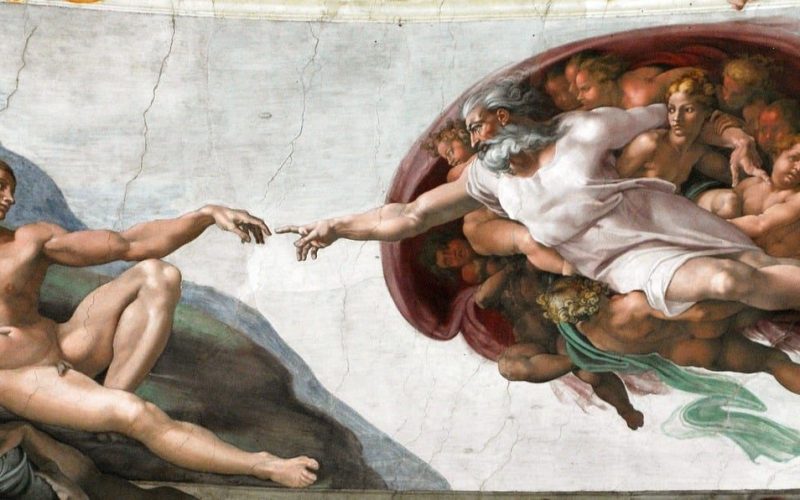Michelangelo – Art & Legacy offers a comprehensive and immersive interpretation of one of the greatest artists in Western history.
Currently housed at 1212 Lincoln Road in Miami Beach, this installation-based exhibition presents full-scale reproductions of Michelangelo’s most iconic works, inviting the public to engage with his art in a setting that merges historical reverence with contemporary exhibition design.
While the original works remain in Italy, the goal here is not replication for its own sake, but interpretation through accessibility. By enabling viewers to experience Michelangelo’s masterpieces at actual size, in detail, and from perspectives often impossible in their original locations, the exhibition bridges the gap between distance and proximity, between academic history and lived visual experience.
Sculptures in Full Scale – A Closer Encounter
The exhibition begins with faithful, full-size reconstructions of Michelangelo’s most well-known sculptures: David, The Pietà, and Moses. Each of these works represents not only technical mastery but a distinct facet of Michelangelo’s artistic vision.
David is perhaps the most recognizable Renaissance sculpture in the world. Here, it appears as originally conceived — monumental, youthful, alert. Viewers are given the rare opportunity to observe the anatomical precision, the expression of anticipation in the eyes, and the subtle dynamism of the pose. Without the crowds of Florence or the physical separation of a museum pedestal, David becomes more than a symbol: he becomes a study in human potential.
The Pietà offers a stark contrast. This reproduction captures the tenderness and sorrow of Mary cradling the body of Christ with remarkable emotional weight. The composition’s complexity, the drapery, and the fine balance between the figures evoke Michelangelo’s capacity to merge spiritual devotion with sculptural form.
Moses, seated with his muscular tension and intense gaze, commands attention. The horns, drawn from a mistranslation of scripture, and the weight of divine burden in his expression, provide a powerful insight into Michelangelo’s theological and psychological depth. All three sculptures benefit from the freedom of movement allowed in the exhibition — visitors can walk around them, observe from multiple angles, and absorb their scale without barriers.
The Sistine Chapel Recreated – Seeing the Ceiling Differently
The central attraction of the exhibition is the reimagining of the Sistine Chapel ceiling. This immersive environment allows visitors to view the fresco cycle at eye level, revealing details that are often invisible when craning one’s neck in the Vatican.
The presentation is not just educational — it is revelatory. The Creation of Adam, one of the most iconic images in the history of art, can be examined up close. The gestures, the color palette, the anatomical expressiveness — all take on new life in this setting. Visitors are encouraged to contemplate not just the beauty of the scene, but its underlying theological and philosophical themes.
Beyond this central panel, the surrounding frescoes — including The Fall of Man, The Deluge, and numerous depictions of prophets and sibyls — are given equal attention. Each figure, framed by architectural trompe-l’œil and surrounded by ignudi (idealized nude male figures), contributes to Michelangelo’s grand narrative of creation, sin, and redemption.
What is most compelling about this aspect of the exhibition is the sense of spatial immersion. The ceiling is no longer distant or monumental — it is intimate. One begins to see Michelangelo less as a distant historical figure and more as a designer, thinker, and builder of meaning.
Multisensory Curation – Atmosphere and Engagement
In terms of exhibition design, Michelangelo – Art & Legacy succeeds in creating a contemplative environment. The use of lighting subtly shifts according to the artwork and space, guiding the viewer without distraction. A curated soundtrack, largely choral and atmospheric, reinforces the spiritual context of the works without being overbearing.
This careful attention to environment allows for slow viewing — a rarity in today’s visual culture. The exhibition does not overwhelm with information. Instead, it encourages close looking, introspection, and a personal relationship with the works on display.
Participatory Elements – The Creative Lab
To complement the observational experience, the exhibition includes a Creative Lab where visitors can explore Michelangelo’s techniques through drawing and sculpting activities. This space is particularly effective in educational contexts, offering hands-on engagement for school groups, families, and aspiring artists.
More importantly, it grounds the exhibition in process — reminding visitors that Michelangelo’s genius was not spontaneous. It was developed, practiced, and refined. By engaging in the creative process, visitors experience a tactile connection to the discipline and labor behind the masterpieces.
Accessibility and Educational Value
One of the strongest features of the exhibition is its democratization of art. Many people will never have the opportunity to visit the Vatican or Florence. This exhibition, by bringing full-scale reproductions into an accessible public space, allows for meaningful encounters with the canon of Western art without requiring international travel, scholarly knowledge, or institutional mediation.
It is also multilingual, inclusive, and clearly organized — with guides and didactics available to enhance learning without being didactic. Whether a visitor spends twenty minutes or two hours inside, the exhibition adjusts to individual levels of interest and prior knowledge.
Final Reflections
Michelangelo – Art & Legacy is not a substitute for the original works — nor does it pretend to be. Instead, it serves as an invitation: to look closer, to reflect longer, and to consider the legacy of a man whose art continues to define what it means to be human.
In its careful curation, respectful design, and educational approach, the exhibition honors Michelangelo not as a mythic figure, but as a master craftsman whose influence endures. Whether for a first-time viewer or a seasoned art enthusiast, it provides a compelling and deeply rewarding experience — one that affirms that great art does not age. It simply waits to be seen again.


